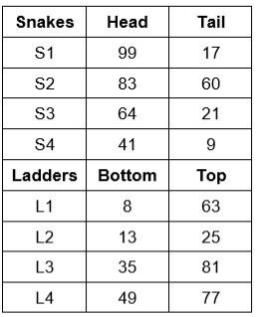Games and Tournament for CAT Sheet 2
- Jul 10
- 5 min read

Practicse Question
Games and Tournament for CAT Case 1
Direction for quesion 1-4: Answer the following question based on the information given below.
Two friends Shaanu & Bhaanu decided to play the game of ‘Snakes & Ladders’, in which two players initially put their tokens at Point 0 and move their token ahead following some rules as given below. Players roll a regular six faced die in turns. The token of the player is moved ahead by as many positions as the number appearing on the die. The winner of the game is the person who reaches or crosses the point 100 first.Meanwhile there are some ‘Snakes’ and ‘Ladders’ in the entire journey. If any player’s token lands at the bottom of a ladder, he/ she can directly move the token up to the top of the ladder. If any player’s token lands on the head of a snake, he/ she will have to directly move the token down to the tail of the snake. There were exactly 4 snakes & 4 ladders in the game. The table given below provides the details of the position of all the Snakes & all the Ladders.

Q.1 Find the minimum number of turns in which a player can finish the game by using exactly 1 ladder.
a.4
b.6
c.7
d.9
Q.2 Shaanu finished his game in exactly nine turns by using exactly one ladder. If he scored 5 in his first turn and 2 in his last turn, in how many ways could he have reached 100?
a.5
b.6
c.7
d.None of these
Q.3 What is the minimum number of turns in which Shaanu could have finished the game if he was bitten by snake S1 exactly once?
a.5
b.8
c.15
d.17
Q.4 Find the minimum number of turns in which Bhaanu could have finished the game if he used the ladder L3.
a.4
b.5
c.9
d.10
Games and Tournament for CAT Case 2
Direction for question 5-8: Answer the following question based on the information given below.
Ajay bought a new chess board (8×8) and was very curious to learn the rules. He learnt that:
The Queen can move any number of vacant squares diagonally, horizontally or vertically.
Rook can move any number of vacant squares horizontally or vertically.
Bishop can move any number of vacant squares diagonally.
Knight can move two squares horizontally & then one vertically or two squares vertically & then one horizontally.
The queen, the rook and the bishop cannot ‘jump’ over the other pieces. For example, as mentioned above, the rook can reach any squares vertically or horizontally. However, if any other piece, say piece A (either our or that of the opponent) is in the same row/column as the rook, the rook cannot reach any square beyond that piece in that row/column. If the piece A belongs to the opponent, the rook can ‘attack’ that piece. This restriction of not ‘jumping over’ other pieces applies to the queen and bishop as well. But the knight can ‘jump over’ the other pieces without any restriction.
The Queen, Rook, Bishop and Knight can attack any other piece of the opponent that falls on the squares that can be reached by them subject to the rules given above.

Note: ‘Vacant’ squares are the ones not occupied by any piece.
The columns are named A to H & rows are numbered 1 to 8 as shown below.
The position of a piece is given by combination of column & rows. D3 means that particular piece is in Dth column & 3rd Row.
Ajay is playing the game of chess with Vijay.
Q.5 If Ajay has his Rook in the square C8 and the Bishop in the square G7, exactly how many squares are there on the chessboard, where any piece of the opponent can be attacked by either Rook or Bishop or by both of them in the next move? (no other pieces are present on the board).
a.12
b.16
c.20
d.25
Q.6 If Ajay has his Knight in the square E3 and the Queen in the square G5, exactly how many squares are there on the chessboard, where any piece of the opponent can be attacked by either Knight or Queen or by both of them in the next move? (no other pieces are present on the board).
a.16
b.18
c.20
d.24
Q.7 If Ajay has his Knight in the square E3 and the Queen in the square G5, exactly how many squares are there on the chessboard, where any piece of the opponent can be attacked by both Knight and the Queen in the next move? (no other pieces are present on the board)
a.2
b.4
c.6
d.8
Q.8 Which of the following pairs given below will leave maximum places unattacked? (Use data from previous questions)
(Note: when a pair given in each of the options is present on the board, no other pieces are present on the board).
a.Rook & Queen
b.Queen & Bishop
c.Bishop & Knight
d.Rook & Knight
Games and Tournament for CAT Case 3
Direction for question 9-12: Answer the questions on the basis of the information given below.

In a recent 4 match One Day Series between India & Australia, the scores of the two captains, Virat & Steve are given below:
It is known that both the batsmen scored only through boundaries (either fours or sixes). Also, each of the two batsmen scored at least two fours & at least two sixes in each of the four matches.
Q.9 Find the maximum number of 6s that could have been hit by any of the players in a particular match.
a.13
b.14
c.15
d.16
Q.10 Find the total number of fours hit by Virat in all the matches combined if we know that number of sixes hit by Virat in each match was a perfect square
a.26
b.37
c.29
d.18
Q.11 Find the total number of sixes scored by Steve in all the matches combined if we know that number of fours scored by Steve in each of the matches is a single digit prime number
a.33
b.24
c.41
d.25
Q.12 ‘x’ represents the maximum number of runs scored by Virat in fours. ‘y’ represents the maximum number of runs scored by Steve in sixes. Find absolute difference between x & y.
a.10
b.22
c.11
d.44
Games and Tournament for CAT Case 4
Direction for question 13-16: Answer the question on the basis of the information given below:
Five teams A, B, C, D and E participated in a round robin league tournament, where each team has to play every other team exactly once. For any team, three points are awarded for a win, one point for a draw and no points for a loss.
The following table gives the points scored by four of the five teams at the end of the tournament.
Team | Points |
A | 6 |
B |
|
C | 5 |
D | 4 |
E | 12 |
Q.13 How many points did team B score?
a.1
b.2
c.3
d.Cannot be determined
Q.14 Which team(s) did team C beat?
a.Only B
b.Only A
c.Only B and D
d.Only E
Q.15 Which of the following team(s) did team A beat?
a.Both C and D
b.Both B and C
c.Both B and D
d.Exactly one of C and D
Q.16 Which team(s) lost more than 50% of the matches that they played?
a.Only A
b.Only A and D
c.Only B
d.A, B and D




Comments